#Indian Space Research Organisation (ISRO)
Text
ISRO using that frugal indian stereotype to land a rocket on the moon with less budget than hollywood movies
#groundbreaking#isro#isromoonmission#chandrayaan3#isromissions#india#south pole mission#indian space research organisation#lets fucking go
84 notes
·
View notes
Text
India has landed on the Moon!!! The landing is part of the Indian Space Research Organisation (ISRO)'s historic Chandrayaan-3 mission.
"'We have achieved soft landing on the moon,'" said ISRO Chairman Shri Somanath. 'Yes, on the moon!'"
"[Indian Prime Minister Narenda Modi] then addressed the ISRO team, speaking in Hindi but adding in English, 'India is now on the moon!'
'The success belongs to all of humanity,' he said. 'And it will help moon missions by other countries in the future. I'm confident that all countries in the world ... can all aspire for the moon and beyond. ... The sky is not the limit!'"
The remote operated lander named Vikram touched down in the south pole region at 6:02pm IST on August 23, 2023. Vikram carried a small but mighty companion, the lunar rover Pragyan (Sanskrit, "wisdom").
Vikram is named after Vikram Sarabhai, PhD, physicist, astronomer, and a major figure in the development of India's space and nuclear programs. Sarabhai served as the first chairman of the ISRO, as well as the driving force behind the organization's creation. Recognizing the need for more coordinated space research in India, Sarabhai urged the Indian government to create INCOSPAR - the committee that eventually formed the ISRO in 1969.
#india moon mission#indian space research organisation#chandrayaan3#ISRO#chandrayaan-3#vikram lander#India moon landing#pragyan rover#Vikram Sarabhai
14 notes
·
View notes
Text
बधाई हो भारत! Congratulations India!
Congratulations India!!
ISRO – Indian Space Research Organisation has achieved the unprecedented soft landing of a probe on the Moon’s South Pole.
Image taken on Internet
This is a huge success for a nation that has been able to successfully send a mission to the Moon on a budget of just under $75 million (around ₹ 615 crore) to build the Chandrayaan-3. As a paragon, Russia’s Luna 25, which…
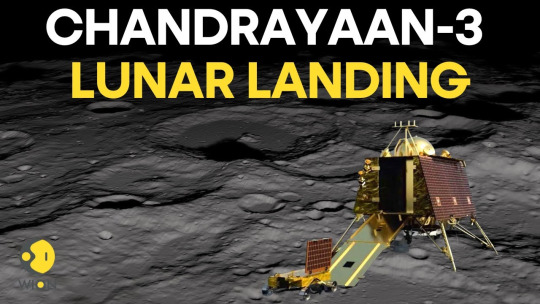
View On WordPress
#Chandrayaan-3#India#Indian Space Research Organisation#ISRO#ISRO - Indian Space Research Organisation#moon#Moon Landing#Moon South Pole#Raffaello Palandri#Space Mission
14 notes
·
View notes
Video
youtube
Chandrayaan-3 some unknown facts #chandrayaan3 #india #isro #motivation ...
#youtube#Chandrayaan-3 is the third lunar mission of the Indian Space Research Organisation (ISRO). It was launched on July 14 2023 from the Satish D
2 notes
·
View notes
Text
Chandrayaan-3: India's Historic Soft Landing on the Moon
Introduction
On August 23, 2023, India made history by successfully landing the Chandrayaan-3 spacecraft on the Moon’s South Pole. This was India’s third lunar mission, and its first soft landing since Chandrayaan-2 in 2019. The successful landing of Chandrayaan-3 is a major achievement for the Indian Space Research Organization (ISRO) and a significant step forward for India’s space…
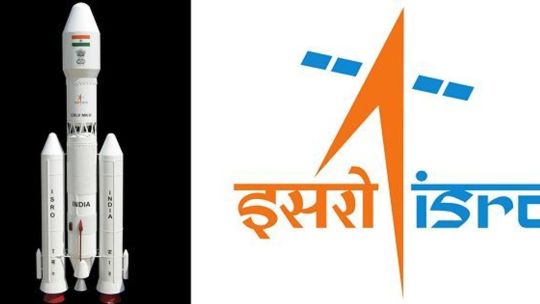
View On WordPress
#Chandrayaan-3#Chandrayaan-3 mission#India&039;s soft landing on Moon#Indian Space Research Organisation (ISRO)#lunar mission#Moon&039;s South Pole#Pragyan rover#scientific instruments#space exploration#Vikram lander
2 notes
·
View notes
Text
See 1st photos of the moon's south pole by India's Chandrayaan-3 lunar lander
By Tereza Pultarova
23 August 2023
India's Chandrayan-3 mission has nailed its lunar landing.

The first images from India's Chandrayaan-3 mission taken after the probe's historic moon touchdown reveal a pockmarked surface near the lunar south pole.
The Indian Space Research Organisation (ISRO) shared the images on X, formerly Twitter, on Wednesday (August 23), about four hours after the Chandrayaan-3 spacecraft completed its smooth descent.
The first set of four images were taken by the lander's Horizontal Velocity Camera as it was nearing the surface of the moon.
An additional image from the Landing Imager Camera, shared a little later, shows a glimpse of the landing site, including a portion of the spacecraft's landing leg and its shadow.
"The communication link is established between the Ch-3 Lander and MOX-ISTRAC, Bengaluru," ISRO said in a post on X.
"Chandrayaan-3 chose a relatively flat region on the lunar surface," the agency added in the subsequent post.
The landing made India only the fourth country in history to successfully put a spacecraft on the surface of the moon, after the United States, the former Soviet Union and China.
Chandrayaan-3 is also the first spacecraft in history to touch down near the lunar south pole, an area that is currently attracting the attention of scientists and space agencies from all over the world.
Scientists think that the permanently shadowed polar craters contain water ice trapped in the rocks, which could be extracted and used to support a permanent human presence on Earth's natural companion.
Moreover, these lunar craters could be used to build next-generation telescopes that would allow astronomers to see farther than they can today.
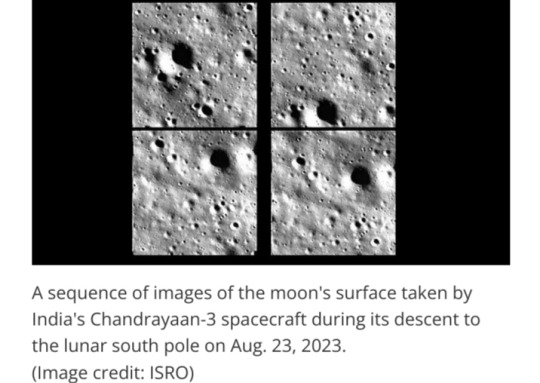
A small rover called Pragyan arrived on board Chandrayaan-3 and will soon deploy and commence its exploration of the exciting region, so many more fascinating images are likely to come soon.
Both the rover and the lander, however, are unlikely to remain operational for more than two weeks, as ISRO doesn't expect the vehicles' batteries to make it through the two-week lunar night.
Chandrayaan-3 was India's second try at landing near the moon's south pole.
The country's first attempt at a lunar touchdown, in September 2019, failed when the Chandrayaan-2 lander crashed into the moon due to a software glitch.
India's triumph comes only three days after Russia lost its Luna-25 mission, its first attempt to put a spacecraft on the moon's surface in 47 years.
Luna-25, too, was aiming for the lunar south pole but crashed into the moon instead after a botched orbital maneuver on Saturday (August 19).
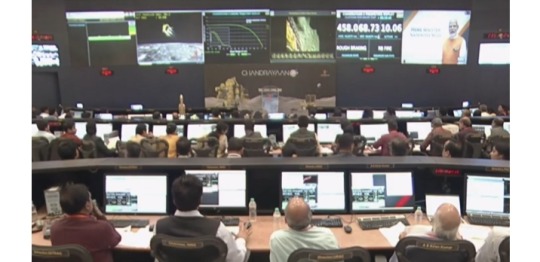


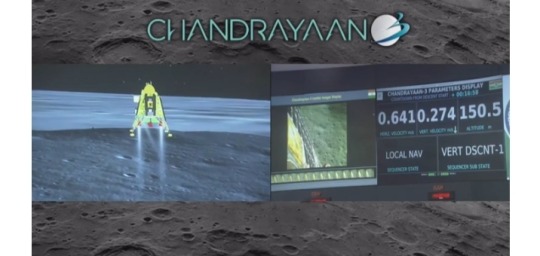

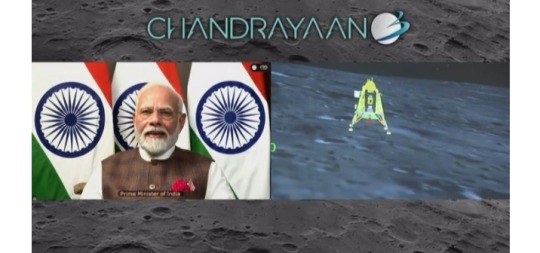
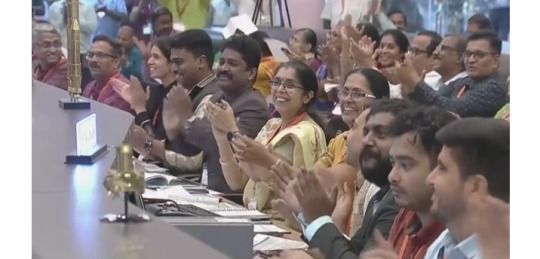
#Chandrayaan-3#Chandrayaan-3 lunar lander#Indian Space Research Organisation (ISRO)#Chandrayaan-3 spacecraft#Horizontal Velocity Camera#Landing Imager Camera#next-generation telescopes#Pragyan#India#moon#lunar landing#spacecraft#moon landing
2 notes
·
View notes
Text
A BRIEF INFORMATION ABOUT ISRO
About ISRO
The Indian Space Exploration Association [a] (ISRO;/ˈɪsroʊ/) is the public space organization of India,
settled in Bengaluru. It works under the Branch of Room (DOS) which is straightforwardly
regulated by the State head of India, while the Director of ISRO goes about as the chief of DOS
too. ISRO is India's essential organization for performing errands connected with space-based
applications, space investigation and the improvement of related advances. [6] It is one of six
government space offices on the planet which have full send off abilities, convey cryogenic
motors, send off extraterrestrial missions and work huge armadas of counterfeit satellites. ISRO fabricated
India's first satellite, Aryabhata, which was sent off by the Soviet Association in 1975. [13] In 1980, ISRO
sent off satellite RS-1 installed its own SLV-3, making India the seventh country to be able to do
undertaking orbital send-offs. SLV-3 was trailed by ASLV, which was hence prevailed by
advancement of numerous medium-lift send off vehicles, rocket motors, satellite frameworks and organizations
empowering the organization to send off many homegrown and unfamiliar satellites and different profound space
missions for space investigation.
History of isro ?
After 1945, significant advancements were made in facilitated space research in India ] by two
researchers: Vikram Sarabhai — organizer behind the Actual Exploration
Research facility at Ahmedabad — and Homi Bhabha , who laid out the Goodbye Organization of Major
Research in 1945. Beginning analyses in space sciences incorporated the investigation of grandiose radiation, high
elevation and airborne testing, profound underground trial and error at the Kolar mines — one of the
most profound mining locales on the planet — and investigations of the upper environment. ] These examinations were finished
at research labs, colleges, and autonomous areas. In 1950, the Division of Nuclear
Energy (DAE) was established with Bhabha as its secretary. [17] It gave subsidizing to space research
all through India. [18] During this time, tests forged ahead with parts of meteorology and the Earth's
attractive field, a subject that had been concentrated on in India since the foundation of the Colaba
Observatory in 1823. In 1954, the Aryabhatta Exploration Foundation of Observational Sciences (ARIES)
was laid out in the lower regions of the Himalayas. [17] The Rangpur Observatory was set up in 1957
at Osmania College, Hyderabad. Under the public authority of Indira Gandhi, INCOSPAR was
supplanted by ISRO. Later in 1972, a space commission and Division of Room (DOS) were set
up to manage space innovation improvement in India explicitly and ISRO was brought under
DOS, regulating space research in India and manufacturing the Indian space program into its current
structure. India joined the Soviet Interkosmos program for space collaboration and got its first
satellite Aryabhatta in circle through a Soviet rocket. The appearance of PSLV in 1990s turned into a significant
support for the Indian space program. Except for its most memorable trip in 1994 and two halfway
disappointments later, PSLV had a dash of in excess of 50 fruitful flights. PSLV empowered India to send off all
of its low Earth circle satellites, little payloads to GTO and many unfamiliar satellites. ] Alongside
the PSLV flights, improvement of another rocket, a Geosynchronous Satellite Send off Vehicle (GSLV)
was going on. India attempted to get upper-stage cryogenic motors from Russia's Glavkosmos however
was obstructed by the US from doing as such. Therefore, KVD-1 motors were imported from Russia under
another understanding which had restricted achievement and an undertaking to create native cryogenic
innovation was sent off in 1994, requiring twenty years to arrive at satisfaction.
About Administrator of isro ?
As of now, the occupant Director of ISRO is S Somanath. He is the current
Secretary (Space) and ex-officio director of the Indian Space Exploration
Association and the Space Commission. Somanath had joined the VSSC in 1985
subsequent to finishing his B. Tech in Mechanical Designing from TKM School of
Designing, Kollam, and Experts in Advanced plane design from Indian Foundation of
Science (ISSC), Bengaluru. he is a specialist in a large group of disciplines including send off
vehicle plan and has worked in the accompanying regions: S Somanath, an
famous technical genius, has been delegated as the administrator of ISRO.
Somanath will succeed Kailasavadivoo Sivan who will finish his
residency on Friday.
Right now, S Somanath is the Overseer of Vikram Sarabhai Space Center
(VSSC) in Kerala.
Brought into the world in July 1963, he sought after mechanical designing from TKM
School of Designing, Kerala. Afterward, in 1985 the technical genius
sought after an experts' certification in Aeronautic design from IISc
Bengaluru.
Being a specialist in sending off vehicle plans, Somanath has particular
in send off of vehicle frameworks designing, foundational layout, underlying
elements and methodology. He likewise well versed in component plan and
fireworks.
Rundown of director of isro ?
ISRO Executive
1. Dr. Vikram Sarabhai
2. Prof. M. G. K. Menon
Residency
From 1963 to 1971
From Jan 1972 to Sept 1972
Lengh of Term
9 years
9 months
3. Prof. Satish Dhawan
4. Prof. U. R. Rao
5. . Dr. K. Kasturirangan
6. G. Madhavan Nair
From 1972 to 1984
From 1984 to 1994
From 1994 to 2003
From2003 to 2009
12 years
10 years
9 years
6years
History of organizer isro ?
Sarabhai was conceived August 12, 1919, in Ahmedabad, India, into a group of industrialists. He
at first learned at Gujarat School, yet later moved to College of Cambridge, Britain.
There, got a bachelor's certification in innate sciences in 1940.
Because of WWII, Sarabhai got back to India, and attempted research in
inestimable beams under Indian physicist Sir Chandrasekhara Venkata Raman, at the Indian
Establishment of Science, Bangalore.
arabhai got back to Cambridge in 1945 to seek after a doctorate. In 1947, he composed a proposition
named "Cosmic Beam Examinations in Tropical Latitudes," as per Britannica. Vikram
Sarabhai, universally viewed as the Dad of the Indian Space Program, was an
Indian physicist and industrialist who started space research, and created
atomic power in India
FAQ
1 Might I at any point join ISRO following 35 years?
How might I join ISRO? Your age ought to be under 35 and have a
least 65% score in your BE/B Tech program. Then step through exams
directed by ISRO.
2 Is ISRO equivalent to NASA?
NASA represents Public Aviation and Space Organization and the
full type of ISRO is the Indian Space Exploration Association.
3 Which branch is best for ISRO?
space science is the investigation of the universe by researchers. To turn into a
space researcher in ISRO, you should seek after a designing or science
course. ISRO generally selects experts with a bosses in mechanical,
electrical or PC designing or a PhD in Cosmology, Material science, or
Science.
4 Is there benefits in ISRO?
SRO representatives are likewise responsible for their annuity after retirement. Other
offices you get are, Clinical offices for yourself as well as your loved ones
individuals, a Restricted Lodging office, Voyaging Concessions,
advance on House Development, Gathering Protection, Financed
bottle, HRA and so on.
5 What is the compensation of ISRO Researcher after 10
years?
Normal ISRO Satellite Center Researcher pay in India is ₹ 14.7 Lakhs for
experience between 2 years to 15 years. Researcher pay at ISRO Satellite
Focus India ranges between ₹ 7.2 Lakhs to ₹ 24.0 Lakhs. As per
our evaluations it is 7% not exactly the normal Researcher Pay in Safeguard &
About ISRO
The Indian Space Exploration Association [a] (ISRO;/ˈɪsroʊ/) is the public space organization of India,
settled in Bengaluru. It works under the Branch of Room (DOS) which is straightforwardly
regulated by the State head of India, while the Director of ISRO goes about as the chief of DOS
too. ISRO is India's essential organization for performing errands connected with space-based
applications, space investigation and the improvement of related advances. [6] It is one of six
government space offices on the planet which have full send off abilities, convey cryogenic
motors, send off extraterrestrial missions and work huge armadas of counterfeit satellites. ISRO fabricated
India's first satellite, Aryabhata, which was sent off by the Soviet Association in 1975. [13] In 1980, ISRO
sent off satellite RS-1 installed its own SLV-3, making India the seventh country to be able to do
undertaking orbital send-offs. SLV-3 was trailed by ASLV, which was hence prevailed by
advancement of numerous medium-lift send off vehicles, rocket motors, satellite frameworks and organizations
empowering the organization to send off many homegrown and unfamiliar satellites and different profound space
missions for space investigation.
History of isro ?
After 1945, significant advancements were made in facilitated space research in India ] by two
researchers: Vikram Sarabhai — organizer behind the Actual Exploration
Research facility at Ahmedabad — and Homi Bhabha , who laid out the Goodbye Organization of Major
Research in 1945. Beginning analyses in space sciences incorporated the investigation of grandiose radiation, high
elevation and airborne testing, profound underground trial and error at the Kolar mines — one of the
most profound mining locales on the planet — and investigations of the upper environment. ] These examinations were finished
at research labs, colleges, and autonomous areas. In 1950, the Division of Nuclear
Energy (DAE) was established with Bhabha as its secretary. [17] It gave subsidizing to space research
all through India. [18] During this time, tests forged ahead with parts of meteorology and the Earth's
attractive field, a subject that had been concentrated on in India since the foundation of the Colaba
Observatory in 1823. In 1954, the Aryabhatta Exploration Foundation of Observational Sciences (ARIES)
was laid out in the lower regions of the Himalayas. [17] The Rangpur Observatory was set up in 1957
at Osmania College, Hyderabad. Under the public authority of Indira Gandhi, INCOSPAR was
supplanted by ISRO. Later in 1972, a space commission and Division of Room (DOS) were set
up to manage space innovation improvement in India explicitly and ISRO was brought under
DOS, regulating space research in India and manufacturing the Indian space program into its current
structure. India joined the Soviet Interkosmos program for space collaboration and got its first
satellite Aryabhatta in circle through a Soviet rocket. The appearance of PSLV in 1990s turned into a significant
support for the Indian space program. Except for its most memorable trip in 1994 and two halfway
disappointments later, PSLV had a dash of in excess of 50 fruitful flights. PSLV empowered India to send off all
of its low Earth circle satellites, little payloads to GTO and many unfamiliar satellites. ] Alongside
the PSLV flights, improvement of another rocket, a Geosynchronous Satellite Send off Vehicle (GSLV)
was going on. India attempted to get upper-stage cryogenic motors from Russia's Glavkosmos however
was obstructed by the US from doing as such. Therefore, KVD-1 motors were imported from Russia under
another understanding which had restricted achievement and an undertaking to create native cryogenic
innovation was sent off in 1994, requiring twenty years to arrive at satisfaction.
About Administrator of isro ?
As of now, the occupant Director of ISRO is S Somanath. He is the current
Secretary (Space) and ex-officio director of the Indian Space Exploration
Association and the Space Commission. Somanath had joined the VSSC in 1985
subsequent to finishing his B. Tech in Mechanical Designing from TKM School of
Designing, Kollam, and Experts in Advanced plane design from Indian Foundation of
Science (ISSC), Bengaluru. he is a specialist in a large group of disciplines including send off
vehicle plan and has worked in the accompanying regions: S Somanath, an
famous technical genius, has been delegated as the administrator of ISRO.
Somanath will succeed Kailasavadivoo Sivan who will finish his
residency on Friday.
Right now, S Somanath is the Overseer of Vikram Sarabhai Space Center
(VSSC) in Kerala.
Brought into the world in July 1963, he sought after mechanical designing from TKM
School of Designing, Kerala. Afterward, in 1985 the technical genius
sought after an experts' certification in Aeronautic design from IISc
Bengaluru.
Being a specialist in sending off vehicle plans, Somanath has particular
in send off of vehicle frameworks designing, foundational layout, underlying
elements and methodology. He likewise well versed in component plan and
fireworks.
Rundown of director of isro ?
ISRO Executive
1. Dr. Vikram Sarabhai
2. Prof. M. G. K. Menon
Residency
From 1963 to 1971
From Jan 1972 to Sept 1972
Lengh of Term
9 years
9 months
3. Prof. Satish Dhawan
4. Prof. U. R. Rao
5. . Dr. K. Kasturirangan
6. G. Madhavan Nair
From 1972 to 1984
From 1984 to 1994
From 1994 to 2003
From2003 to 2009
12 years
10 years
9 years
6years
History of organizer isro ?
Sarabhai was conceived August 12, 1919, in Ahmedabad, India, into a group of industrialists. He
at first learned at Gujarat School, yet later moved to College of Cambridge, Britain.
There, got a bachelor's certification in innate sciences in 1940.
Because of WWII, Sarabhai got back to India, and attempted research in
inestimable beams under Indian physicist Sir Chandrasekhara Venkata Raman, at the Indian
Establishment of Science, Bangalore.
arabhai got back to Cambridge in 1945 to seek after a doctorate. In 1947, he composed a proposition
named "Cosmic Beam Examinations in Tropical Latitudes," as per Britannica. Vikram
Sarabhai, universally viewed as the Dad of the Indian Space Program, was an
Indian physicist and industrialist who started space research, and created
atomic power in India
FAQ
1 Might I at any point join ISRO following 35 years?
How might I join ISRO? Your age ought to be under 35 and have a
least 65% score in your BE/B Tech program. Then step through exams
directed by ISRO.
2 Is ISRO equivalent to NASA?
NASA represents Public Aviation and Space Organization and the
full type of ISRO is the Indian Space Exploration Association.
3 Which branch is best for ISRO?
space science is the investigation of the universe by researchers. To turn into a
space researcher in ISRO, you should seek after a designing or science
course. ISRO generally selects experts with a bosses in mechanical,
electrical or PC designing or a PhD in Cosmology, Material science, or
Science.
4 Is there benefits in ISRO?
SRO representatives are likewise responsible for their annuity after retirement. Other
offices you get are, Clinical offices for yourself as well as your loved ones
individuals, a Restricted Lodging office, Voyaging Concessions,
advance on House Development, Gathering Protection, Financed
bottle, HRA and so on.
5 What is the compensation of ISRO Researcher after 10
years?
Normal ISRO Satellite Center Researcher pay in India is ₹ 14.7 Lakhs for
experience between 2 years to 15 years. Researcher pay at ISRO Satellite
Focus India ranges between ₹ 7.2 Lakhs to ₹ 24.0 Lakhs. As per
our evaluations it is 7% not exactly the normal Researcher Pay in Safeguard &
4 notes
·
View notes
Video
youtube
Information on the upcoming ISRO (Indian Space Research Organisation) mission to Venus
#venus#isro#planet venus#indian space research organisation#planets#solar system#space research#planetary science#venusian#astronomy#science#stem fields#space#venuscore#spacecore
3 notes
·
View notes
Link
India's ambitious Gaganyaan mission has captured the world's attention as it prepares to send its first astronauts into space. The Indian Space Research Organisation (ISRO) recently announced the selection of astronauts who will be part of this historic journey, marking a significant milestone in the country's space exploration endeavors.
The Gaganyaan mission holds immense significance for India on various fronts. It not only demonstrates India's technological prowess but also reaffirms its status as a spacefaring nation. As the fourth country in the world to undertake a manned space mission, India's endeavor highlights its commitment to pushing the boundaries of space exploration.
0 notes
Text
Aditya-L1: India's Pioneering Solar Mission Set to Enter Orbit Today
Introduction:
In a significant milestone for India’s space exploration endeavors. The Indian Space Research Organisation’s (ISRO) Aditya-L1 To Enter Orbit today mission, the nation’s first solar observation mission, is poised to reach its final destination orbit today. Launched on September 2, 2023, from ISRO’s Sriharikota launchpad. The Aditya-L1 mission is a testament to India’s commitment to…

View On WordPress
#Aditya-L1 carries seven payloads#Aditya-L1 mission#Aditya-L1 To Enter Orbit today#Indian Space Research Organisation&039;s (ISRO)
0 notes
Text
congratulations to all the isro scientists that worked to make chandrayaan 3 possible!
39 notes
·
View notes
Text
Aditya-L1: India's Pioneering Solar Mission Set to Enter Orbit Today
Introduction:
In a significant milestone for India’s space exploration endeavors. The Indian Space Research Organisation’s (ISRO) Aditya-L1 To Enter Orbit today mission, the nation’s first solar observation mission, is poised to reach its final destination orbit today. Launched on September 2, 2023, from ISRO’s Sriharikota launchpad. The Aditya-L1 mission is a testament to India’s commitment to…
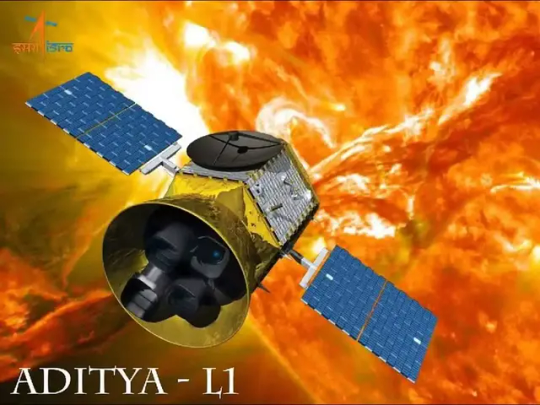
View On WordPress
#Aditya-L1 carries seven payloads#Aditya-L1 mission#Aditya-L1 To Enter Orbit today#Indian Space Research Organisation&039;s (ISRO)
0 notes
Link
In an interview during the 74th IAC (International Astronautical Congress), ISRO Chief S Somanath stated, “After the success of Gaganyaan, India would embark on constructing its own space station.” Read More
#isro#isroindia#isromissions#isromoonmission#chandrayaanlaunch#gaganyaan#iac#international astronautical congress#s somanath#ISRO Chief S Somanath#indian space research organisation#spaceflight#space station#space exercises#space station development#news#space news
0 notes
Text
KCP Group hands critical equipment for India’s human space flight mission for testing
By T. S. Shankar
Chennai: A city-based company has achieved a key milestone by fabricating critical hardware for India’s human space flight mission, handing over two crew model structures for testing to the government space agency.
KCP Goup’s Heavy Engineering division, also based in Chennai, had produced the two Integrated Air-Drop Test – Crew Models (IADT-CM), each costing Rs. 1 crore, for…
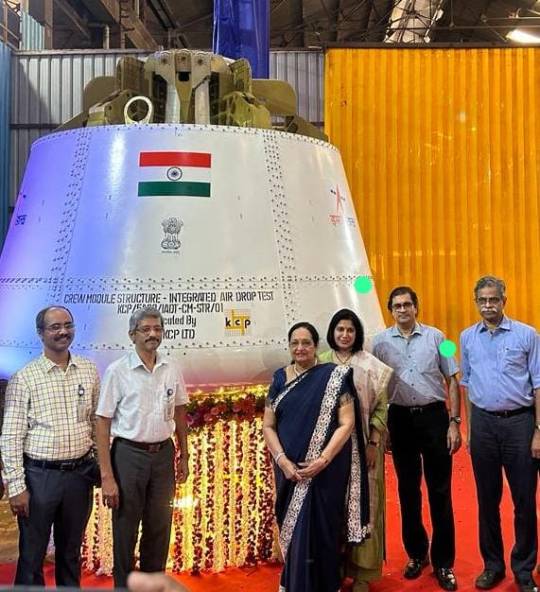
View On WordPress
#Aerospace#Air Force#Chandrayaan#Crew Model#Dr V. L. Indira Dutt#Gaganyaan#GSLV#Heavy Engineering#HSFC#Human Space Flight Centre#Hutton R.#IAF#India#Indian Air Force#Indian Space Research Organisation#Indira Dutt#Industry#Integrated Air Drop Test#ISRO#KCP Limited#R. Hutton#Space#Space Sector#Space Technology
1 note
·
View note
Text
Explore the Aditya L1 Mission, India's groundbreaking venture to uncover the Sun's mysteries. Discover its objectives and impact on space weather.
1 note
·
View note
Link
Chandrayaan-3 has successfully initiated its ascent from Sriharikota, thereby advancing India's space exploration endeavors to unprecedented levels. The GSLV Mark 3 (LVM 3) heavy-lift launch vehicle has taken off seamlessly from the Satish Dhawan Space Centre in Andhra Pradesh's Sriharikota, by the predetermined launch schedule.
#chandrayaan#chandrayaan3#chandrayaanlaunch#chandrayaanlanding#chandrayaanmission#chandrayaan isro#isro#isro india#indian#indian space research organisation#indian space#isro lunar mission#isro space#isro space mission#newsprovider#newsprovidernetwork#thegyaaneeknowledge#india#science#technology
1 note
·
View note